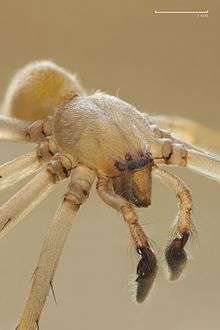Cheiracanthium mildei
Cheiracanthium mildei is a species of spider from the family Cheiracanthiidae. C. mildei is commonly known as the northern yellow sac spider, a name it shares with many other spiders of its genus.[1]
| Cheiracanthium mildei | |
|---|---|
 | |
| Male Cheiracanthium mildei | |
| Scientific classification | |
| Kingdom: | Animalia |
| Phylum: | Arthropoda |
| Subphylum: | Chelicerata |
| Class: | Arachnida |
| Order: | Araneae |
| Infraorder: | Araneomorphae |
| Family: | Cheiracanthiidae |
| Genus: | Cheiracanthium |
| Species: | C. mildei |
| Binomial name | |
| Cheiracanthium mildei C. L. Koch, 1839 | |
Description
C. mildei usually has a pale green or tan body, with darker brown palpi and chelicerae. An adult C. mildei is usually 7–10 millimetres (0.3–0.4 in) in body size. Each leg ends in double claws, and the front pair is significantly longer (up to two times the size, however it is clearly shorter than in C. inclusum species).[1] The eyes have a tapetum lucidum that reflects back to the light source once lit, suggesting that the spiders have good to excellent vision and are agile prey hunters. Although this spider can bite humans, the effects appear to be mild.[2]
Habitat and distribution
C. mildei is widespread across the northeastern United States and eastern Canada, as well as most of northern Europe and can be found outside, or more commonly inside houses. The American species is thought to have been introduced there from Europe by the English colonists.
Prey and predators
C. mildei is a dominant predator of S. littoralis (a moth species) in Africa and Mid Eastern regions. The mechanism of predation include causing direct death by consuming the larvae and causing indirect death by dispersing larvae from its host plants.[3]
References
- "Spiders of the NW". Woodland Park Zoo. Retrieved 2012-11-20.
- "Verified bites by Yellow Sac spiders (genus Cheiracanthium) in the United States and Australia: Where is the necrosis?". The American Journal of Tropical Medicine and Hygiene. Retrieved 2015-05-10.
- Mansour, Fadel; Rosen, David; Shulov, A (1981). "Disturbing effect of a spider on larval aggregations of Spodoptera littoralis". Entomologia Experimentalis et Applicata. 29 (2): 234–237. doi:10.1111/j.1570-7458.1981.tb03063.x.